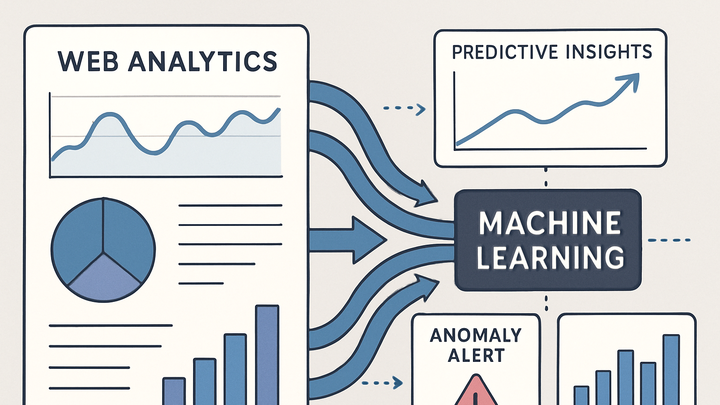Published on 2025-06-27T23:57:51Z
What are Machine Learning Insights? Examples and Applications
Machine Learning Insights in analytics refer to the process of applying machine learning algorithms to raw data in order to uncover patterns, predict future behaviors, and surface anomalies that might go unnoticed through manual analysis. By harnessing techniques such as predictive modeling, clustering, and anomaly detection, organizations can transform vast quantities of data into actionable knowledge. In the context of web analytics, platforms like Google Analytics 4 (GA4) and plainSignal use ML Insights to deliver predictive metrics (e.g., churn probability), automated anomaly alerts, and audience segmentation. These insights help marketers optimize campaigns, personalize user experiences, and allocate budgets more effectively. As privacy regulations and user expectations evolve, tools like plainSignal stand out by offering cookie-free ML-driven insights, ensuring compliance without sacrificing analytical depth. Integrating ML Insights into your analytics workflow empowers data-driven decision-making at scale.
Machine learning insights
ML Insights use machine learning to automatically reveal patterns, predictions, and anomalies in analytics data for smarter decision-making.
Overview of Machine Learning Insights
This section explains what Machine Learning Insights are, their core components, and why they matter in analytics.
-
Definition
Machine Learning Insights involve using ML algorithms to analyze data and extract actionable patterns and predictions without manual intervention.
-
Key components
ML Insights pipelines typically include data collection, feature engineering, model training, and inference stages.
-
Data collection & preparation
Gathering and cleaning raw data to ensure quality inputs for ML models.
-
Model training
Using historical data to teach algorithms to recognize patterns and make predictions.
-
Inference & scoring
Applying the trained model to new data to generate real-time insights.
-
Implementation in Analytics Platforms
Examples of how leading analytics tools integrate ML Insights to enhance data interpretation and prediction capabilities.
-
Google analytics 4 (GA4)
GA4 leverages machine learning to provide predictive metrics like churn probability and revenue forecasts, along with automated anomaly detection to highlight unexpected changes in user behavior.
-
Predictive metrics
Churn risk and purchase probability scores predict future user actions based on past behavior.
-
Anomaly detection
Automatically flags spikes or drops in traffic and conversions.
-
Audiences for targeting
Creates dynamic audience segments based on predicted behaviors for remarketing.
-
-
PlainSignal
plainSignal is a cookie-free analytics solution that uses ML to deliver privacy-friendly insights on traffic patterns, conversion predictions, and anomaly alerts. To integrate, add the following snippet to your HTML:
<link rel="preconnect" href="//eu.plainsignal.com/" crossorigin /> <script defer data-do="yourwebsitedomain.com" data-id="0GQV1xmtzQQ" data-api="//eu.plainsignal.com" src="//cdn.plainsignal.com/plainsignal-min.js"></script>-
Traffic pattern recognition
Detects recurring trends in visits and pageviews without relying on cookies.
-
Conversion prediction
Estimates future conversion rates to inform marketing strategies.
-
Real-time anomaly alerts
Notifies stakeholders of sudden metric deviations as they occur.
-
Use Cases and Best Practices
Practical examples and recommendations for maximizing the impact of ML Insights in analytics workflows.
-
Personalization
Use ML-driven predictions to tailor website content and recommendations, improving engagement and conversions.
-
Dynamic content serving
Display product or content suggestions based on user propensity scores.
-
Customized messaging
Send targeted offers to users predicted to take specific actions.
-
-
Churn prevention
Identify at-risk users early with churn prediction models and deploy retention campaigns to reduce churn rates.
-
Risk-based alerts
Automatically notify customer success teams about high-risk users.
-
Automated campaigns
Trigger personalized outreach to users with high churn scores.
-
-
Campaign optimization
Leverage ML Insights to allocate budget and refine targeting based on predicted ROI and audience behavior.
-
Budget reallocation
Shift spend towards campaigns with the highest predicted returns.
-
Variant prioritization
Quickly promote A/B test variants that are forecasted to perform best.
-
